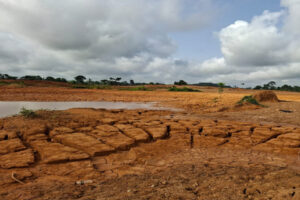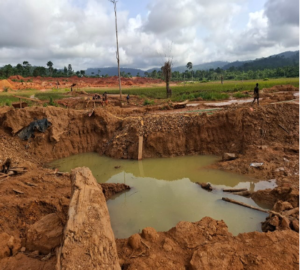
Ghana is a low middle-income country with abundant mineral and agricultural resources. Regions which are the major agro-ecological zones simultaneously have the largest deposits of mineral resources. Over the past decades, small-scale gold mining (galamsey) activities within the country has surged at alarming rates. Although economically beneficial, these activities have left behind numerous abandoned mining sites, creating environmental hazards, and reducing the available arable land. Reclaiming these abandoned sites for agricultural purposes goes a long way to address environmental degradation, setting a sustainable path towards enhancing food security and promoting rural development. This proposal outlines a comprehensive plan for converting abandoned mining lands into productive agricultural zones, aligning with Ghana’s sustainable development goals of eliminating poverty, ending hunger, and enhancing food security.
Problem Statement & Context
Abandoned mining sites, resulting from small-scale mining (galamsey) activities in Ghana pose significant challenges, including deforestation, chemical contamination of soil and nearby water bodies, reduction of soil fertility through the destruction of top and sub-soils, aggravated soil erosion, and loss of biodiversity. These lands are mostly left barren, with degraded soil and limited potential for vegetation to recover naturally. Local communities suffer from the loss of arable land, water pollution, and health risks associated with residual mining waste. Addressing these issues is critical for improving environmental health, restoring ecosystems, and providing economic opportunities through agriculture.

FIG. 2: Mining effect on groundwater
Project Objectives & Rationale

FIG.3: Mining pit left uncovered after mining
Objectives:
- Soil Remediation: To rehabilitate contaminated soils to a level that is suitable for agricultural purposes.
- Sustainable Agriculture Development: To establish sustainable farming practices on reclaimed lands.
- Community Engagement: To involve local communities in the reclamation process and ensure their benefit.
- Biodiversity Restoration: To restore flora and fauna native to environment, and promote ecological balance.
- Economic Empowerment: To create economic opportunities for local communities through agricultural activities.
Rationale:
Expected Outcomes:
- Improved soil quality and fertility.
- Establishment of productive agricultural land.
- Increased community involvement and ownership of projects.
- Enhanced biodiversity and ecosystem services.
- Development of new markets for agricultural produce.
Expected Impacts:
- Enhanced food security in local communities.
- Reduction in environmental pollution and health hazards.
- Sustainable economic development in rural areas.
- Increased resilience against climate change impacts.
- Strengthened social cohesion and community resilience
4. Project Approach and Methodology
The project will be implemented in the following phases:
Phase 1: Site Assessment and Planning
- Conduct comprehensive soil and environmental assessments.
- Identify suitable plant species for soil remediation and agriculture.
- Develop a detailed project plan, including timelines and resource allocation.
Phase 2: Soil Remediation
- Level lands that have been extensively degraded.
- Apply bioremediation techniques using microorganisms and phytoremediation with hyperaccumulator plants.
- Monitor soil health and adjust remediation strategies as needed.
Phase 3: Agricultural Development
- Prepare land for farming by improving soil structure and fertility.
- Introduce sustainable farming practices, including crop rotation, organic farming, and agroforestry.
- Provide training and resources to local farmers.
Phase 4: Community Engagement and Training
- Organize workshops and training sessions for local communities.
- Establish community cooperatives to manage and sustain agricultural activities.
- Facilitate market access for agricultural produce.
Phase 5: Monitoring and Evaluation
- Regularly monitor soil quality, crop yield, and environmental impact.
- Conduct periodic evaluations to assess project progress and outcomes.
5. Data Parameters
Key data parameters to be collected and analyzed include:
- Soil pH, nutrient levels, and contaminant concentrations.
- Plant growth rates and crop yields.
- Biodiversity indices, including species richness and abundance.
- Water quality parameters in adjacent water bodies.
- Socio-economic data, including income levels and employment rates in local communities.
6. Project Products and Dissemination Plan
The project will produce the following deliverables:
- Comprehensive soil and environmental assessment reports.
- Guidelines and manuals on sustainable agriculture practices.
- Case studies and success stories from reclaimed sites.
- Policy briefs and recommendations for scaling up the project.
Dissemination Plan:
- Publish findings in scientific journals and present at conferences.
- Share results through workshops, seminars, and community meetings.
- Collaborate with government agencies, NGOs, and international organizations to promote best practices.
7. Quality Assurance Data Collection and Analysis
To ensure data quality and reliability, the project team will:
- Implement standardized protocols for data collection and analysis.
- Use calibrated and validated equipment for soil and water testing.
- Conduct regular audits and peer reviews of data.
- Train project staff in data collection and analysis techniques.
8. Significance of the Project
Degraded lands that have been abandoned by small-scale mining (galamsey) activities in Ghana can be reclaimed for agricultural purposes. This will provide a unique opportunity for combating environmental degradation and promoting sustainable development initiatives in Ghana. This project will revive ecosystems, improve agricultural productivity, enhance food security, and provide economic avenues for local populations. The project will complement local and global initiatives to achieve environmental sustainability and rural development by converting degraded mining sites into viable agricultural fields. Upon completion, the intervention will serve as a template for similar reclamation projects in areas facing the devastating impct of small-scale mining activities.


